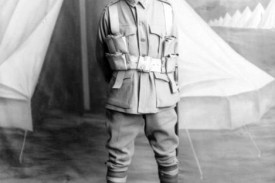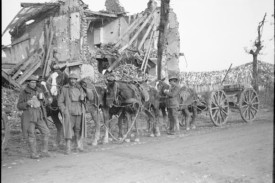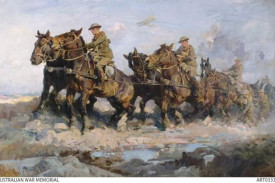General News
15 February, 2025
Veterans' Voices: Robert Clarence Jones
Robert Clarence Jones was born in Borung, Rupanyup.
On enlistment his occupation was farmer and his next of kin was his step-father, J Ellis of Nandaly via Sea Lake.
Private Robert Clarence Jones of 9th Reinforcements 8th Battalion of Rupanyup joined from 9th Rifles (Anzac).
He enlisted on July 17 1915.
His service number was 2945.
Robert was 23 years and 10 months of age.
He sailed from Melbourne aboard HMAT SS Makarini on either September 10 or 15 1915.
Robert served with his first unit, 48 Company, from July 19 to 21 1915.
He was transferred to 4/24 Reinforcements on July 21.
Robert was marched into 12th Training Battalion and sailed aboard Empress of Britain to Alexandria, Egypt, landing on January 7 1916.
He was taken on strength to 60th Battalion at Serapeum, Tel at Kibri, from 8th Battalion on February 24 1916.
He served with to 3rd Field Artillery up to March 17 1916, taken on strength to 23rd Howitzer Brigade.
He was mustered as a driver on May 18.
He proceeded to serve with the British Expeditionary Force at Alexandria.
On June 18 1916 Robert left to serve in France, disembarking at Marseilles on June 27.
He was transferred to 115 Battery on July 7.
Robert was taken on strength to 3rd (Army) Field Artillery Brigade.
On December 26 1917 he was in Admin 2nd Southern General Hospital NYP.
On March 2 1918 he was posted overseas to France via South Hampton in England from 12th Training Battalion, Cosford.
On April 27 1918 he was admitted to hospital sick.
On April 30 he was serving at line of communication headquarters.
Robert was taken on strength from reinforcements of 46th Battalion.
On June 6 1918 he was discharged to Base Depot.
Robert rejoined his unit from leave on September 12 1918 as a driver.
He was wounded in action on September 14 1918.
He was admitted to 13 Field Hospital, then transferred to 13 AT 19 on September 15.
Robert was transferred from Havre, France, to the UK aboard HS Guilford Castle on September 16.
He was admitted to 3rd Western General Hospital Cardiff, England, with a gunshot wound in the left buttocks on September 17 1918.
He took furlough from October 7 to 21 1918, then was to report to No 2 C Depot.
However, Robert contracted influenza on October 9 and was in King George Hospital at Stanford Street.
Robert was to take furlough from October 16 to 30 October.
On discharge he was to report to No 4 CD and was marched from administration.
He was re-admitted sick, this time to No 2 Group Hospital, again with influenza, on November 2 1918.
On November 12 Robert was marched into No 2 Group England.
As a driver he was sent back overseas to serve with Ing Brigade before returning to RBAA Heytesbury on December 6 1918.
From there he was posted overseas once more on December 28.
He began the return voyage to Australia on January 23 or 25 1919 aboard Ceramic as a member of 3rd Field Artillery Brigade.
He was discharged at 3 MD 2 (42nd Battalion) TPE on August 10 1919.
'Driver' was a military rank used in the British Army and the armies of other Commonwealth countries.
It was equivalent to the rank of private.
The rank of driver was initially used in the Royal Artillery for the men who drove the teams of horses which pulled the guns.
There were drivers from the wagon-lines who daily and nightly brought up ammunition across the mud.
Australians who were supposed to be in fairly safe jobs, the drivers took pride in showing what they could do when they came into the thick of it.
These Australians won themselves a special name on the battlefield for the way in which they went straight through the nightmare barrages laid on the well-known tracks which they and their horses had to follow.
Where many might have hesitated, these men realised that the loss would be less, and the job better done, if they pushed on without hesitation.
It was undoubtedly through the conduct of the drivers, as well as through that of the gun-crews and observers, that Australian divisional artilleries earned the admiration and praise of all.
With thanks: Sally Bertram, RSL Military History Library.
Contact Sally at sj.bertram@hotmail.com or call 0409 351 940.


